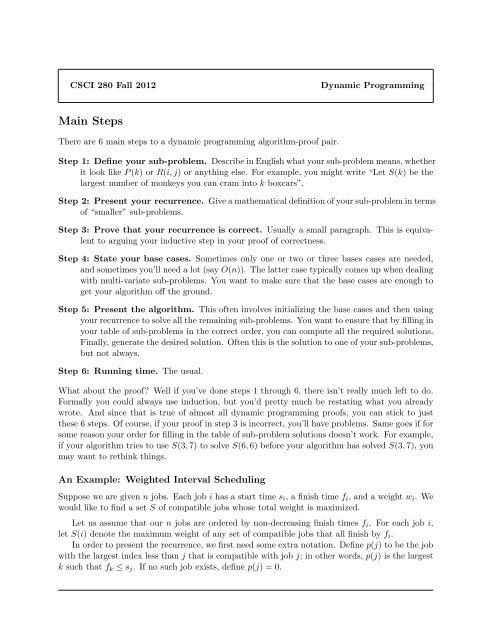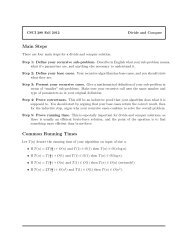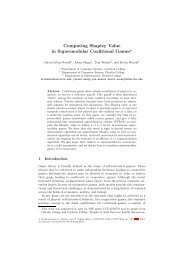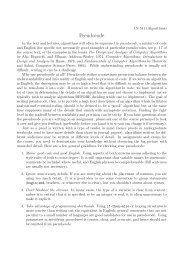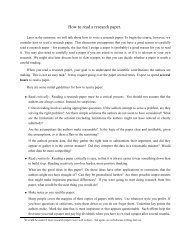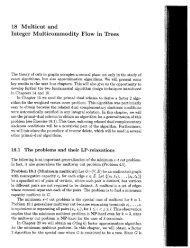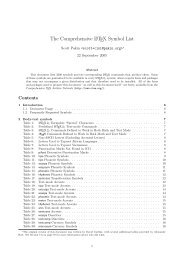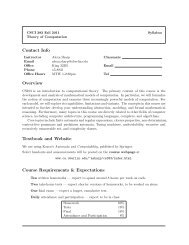Dynamic Programming Proofs
Dynamic Programming Proofs
Dynamic Programming Proofs
Create successful ePaper yourself
Turn your PDF publications into a flip-book with our unique Google optimized e-Paper software.
CSCI 280 Fall 2012<br />
<strong>Dynamic</strong> <strong>Programming</strong><br />
Main Steps<br />
There are 6 main steps to a dynamic programming algorithm-proof pair.<br />
Step 1: Define your sub-problem. Describe in English what your sub-problem means, whether<br />
it look like P (k) or R(i, j) or anything else. For example, you might write “Let S(k) be the<br />
largest number of monkeys you can cram into k boxcars”.<br />
Step 2: Present your recurrence. Give a mathematical definition of your sub-problem in terms<br />
of “smaller” sub-problems.<br />
Step 3: Prove that your recurrence is correct. Usually a small paragraph. This is equivalent<br />
to arguing your inductive step in your proof of correctness.<br />
Step 4: State your base cases. Sometimes only one or two or three bases cases are needed,<br />
and sometimes you’ll need a lot (say O(n)). The latter case typically comes up when dealing<br />
with multi-variate sub-problems. You want to make sure that the base cases are enough to<br />
get your algorithm off the ground.<br />
Step 5: Present the algorithm. This often involves initializing the base cases and then using<br />
your recurrence to solve all the remaining sub-problems. You want to ensure that by filling in<br />
your table of sub-problems in the correct order, you can compute all the required solutions.<br />
Finally, generate the desired solution. Often this is the solution to one of your sub-problems,<br />
but not always.<br />
Step 6: Running time. The usual.<br />
What about the proof? Well if you’ve done steps 1 through 6, there isn’t really much left to do.<br />
Formally you could always use induction, but you’d pretty much be restating what you already<br />
wrote. And since that is true of almost all dynamic programming proofs, you can stick to just<br />
these 6 steps. Of course, if your proof in step 3 is incorrect, you’ll have problems. Same goes if for<br />
some reason your order for filling in the table of sub-problem solutions doesn’t work. For example,<br />
if your algorithm tries to use S(3, 7) to solve S(6, 6) before your algorithm has solved S(3, 7), you<br />
may want to rethink things.<br />
An Example: Weighted Interval Scheduling<br />
Suppose we are given n jobs. Each job i has a start time s i , a finish time f i , and a weight w i . We<br />
would like to find a set S of compatible jobs whose total weight is maximized.<br />
Let us assume that our n jobs are ordered by non-decreasing finish times f i . For each job i,<br />
let S(i) denote the maximum weight of any set of compatible jobs that all finish by f i .<br />
In order to present the recurrence, we first need some extra notation. Define p(j) to be the job<br />
with the largest index less than j that is compatible with job j; in other words, p(j) is the largest<br />
k such that f k ≤ s j . If no such job exists, define p(j) = 0.
Our recurrence is S(i) = max{S(i − 1), w i + S(p(i))}.<br />
To prove this is correct, consider the optimal solution for S(i). There are two cases: either job<br />
i is used in the solution for S(i), or it is not.<br />
case 1: If i is not used in the optimal solution for S(i), then the maximum-weight set of compatible<br />
jobs among jobs 1 through i is just the maximum-weight set of compatible jobs among jobs<br />
1 through i − 1; by definition, this is S(i − 1).<br />
case 2: If i is used in the optimal solution for S(i), then since jobs p(i)+1 through i−1 all conflict<br />
with job i, the remaining jobs selected for S(i) are drawn from 1 through p(i). Removing i<br />
from the optimal solution for S(i) yields a compatible solution on jobs 1 . . . p(i). So by the<br />
optimality of S(p(i)), S(i) − w i ≤ S(p(i)). But similarly, adding job i to S(p(i)) is (by the<br />
definition of p(·)) compatible, and only uses jobs up through i. Hence S(i) − w i ≥ S(p(i)).<br />
Therefore S(i) = w i + S(p(i)).<br />
Finally, since S(i) is a maximization, the larger of these two cases is the weight of S(i).<br />
As base cases, we define S(0) = 0 and S(1) = w 1 . This produces the following algorithm.<br />
sort jobs by increasing finish times<br />
compute function p(i) for i from 1 to n<br />
set S(0) = 0 and S(1) = w 1<br />
for i from 2 to n do<br />
set S(i) = max{S(i − 1), w i + S(p(i))}<br />
end for<br />
return S(n)<br />
Sorting takes O(n log n) time. The computation of p(i) can clearly be done in O(n 2 ) time; if<br />
we want to do better, we can either binary search for each i, or all p(i) values can be computed<br />
in a single pass if we have already created a second list of jobs sorted by increasing start times.<br />
Finally, the main loop is linear; therefore the total running time is O(n log n).<br />
Note that we computed the value of an optimal schedule, but not the schedule itself. To<br />
actually compute the actual schedule, we have a few options. One is to use the computed values<br />
S(i) to reverse engineer an optimal set A of jobs to select. Alternatively, we can change the<br />
algorithms so we build lists as we go:<br />
sort jobs by increasing finish times<br />
compute function p(i) for i from 1 to n<br />
set S(0) = 0 and S(1) = w 1<br />
set A(0) = ∅ and A(1) = {1}<br />
for i from 2 to n do<br />
if S(i − 1) > w i + S(p(i)) then<br />
set A(i) = A(i − 1) and S(i) = S(i − 1)<br />
else<br />
set A(i) = {i} ∪ A(p(i)) and S(i) = w i + S(p(i))<br />
end if<br />
end for<br />
return A(n)<br />
This version of the algorithm now requires O(n 2 ) space, since for each index we store a set of jobs<br />
(which may be as large as n). Can you see how to modify this so that it only uses O(n) space?


